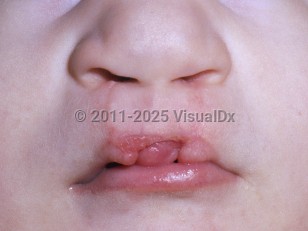Trisomy 13 (Patau or Bartholin-Patau syndrome) is a genetic syndrome caused by an additional copy of chromosome 13. Individuals display significantly impaired cognitive function in 2 or more adaptive behaviors and have defects involving the midface, eye, and forebrain, including microcephaly, holoprosencephaly, microphthalmia, and other lesions such as
polydactyly, rocker bottom feet, cystic kidneys, and
congenital heart defects.
There are three causes of trisomy 13:
- An extra copy of chromosome 13 in all cells,
- An extra copy of chromosome 13 in some cells (mosaic trisomy 13), or
- A Robertsonian translocation involving the long arm of chromosome 13.
The majority of trisomy 13 patients have an extra copy of chromosome 13 in all cells due to chromosomal nondisjunction related to advanced maternal age. Most cases of trisomy 13 are not inherited, though unaffected individuals carrying balanced translocations can transmit extra genetic material to offspring.
The majority of trisomy 13 patients die in utero, with fewer than 5% of affected patients living beyond the first year of life. In cases of mosaic trisomy 13, physical features and disease severity may vary and tend to correlate positively with the number of cells containing the extra chromosome.



